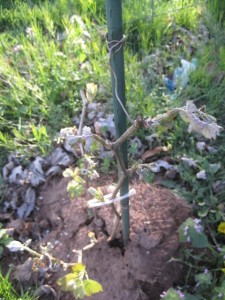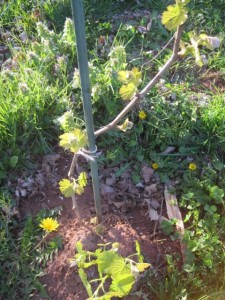An Hour of Frost
Well, it doesn’t take much. The forecast called for temperatures in my part of Fairfax County to dip below freezing for less than two hours, but that was enough to do some damage. At least one of the vines appears to have sailed through the night with flying colors, but the others experienced at least some degree of frost damage. As noted in my

- Some damage on this vine – it’s hard to see in this picture, but compare the shriveled leaves on the right with the green, healthy ones on the left side.
previous post, this is a critical time of the year for vines. Late frost is a threat in any year, but the early bud break this spring left vines everywhere in the state exposed to the threat of frost in the weeks ahead.
As WineMaker magazine noted, late frost is a danger “because the first green growth produced on a new grapevine shoot is two or three basal leaves, immediately followed by the embryonic flower clusters that will become this year’s crop. So, if frost strikes, it can greatly reduce or even wipe out the whole vintage.”
For my vines in Fairfax, I believe the danger is even more acute because they are still small and the buds are so close to the ground, where the temperature is coldest. We’re still new at this, and it’s possible we pruned them back too far over the winter. For the vines we plant this spring, we’ll definitely be focused on strategies for dealing with late frost, and I’ll talk about some of them in an upcoming post.
Of course, one of the most important considerations in dealing with frost is site selection, and we’ve already cast that particular die. The Fairfax vineyard is challenged on at least two counts. It’s at a low elevation, and it’s on flat ground, so the cold air has no place to go. In Nelson County, where we have some vines planted and are preparing to plant another 150, the elevation is higher, around 750 feet, but not high enough to put us in the atmospheric sweet spot that probably runs from about 800 to 1,600 feet above sea level. On the other hand, the land is sloped, so the heavier cold air should flow down hill and off the vineyard. We’ll see.
But no matter how well you plan, you may still find yourself dealing with late frost. I suspect most commercial vineyards in the state were monitoring the vines throughout the night and taking steps to mitigate the frost threat. Larger vineyards have a number of tools they can bring to bear, including wind machines, heaters, and helicopters. Many vineyards gather the wood pruned from the vines over the winter and leave it at the end of the rows to burn on nights where frost threatens.
This year, we didn’t have a lot of choices beyond praying and hoping. However, the Fairfax vineyard is only experimental; I’m not expecting to ever make wine from those grapes, although it would be a definite bonus if I do. But for the vines we are putting in the ground this Spring, we’ll probably have some sleepless spring nights in our future.
Category: All Posts, Viticulture




Comments (1)
Trackback URL | Comments RSS Feed
Sites That Link to this Post